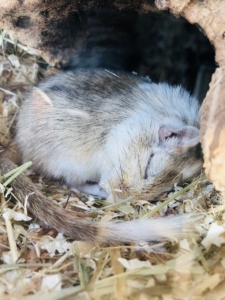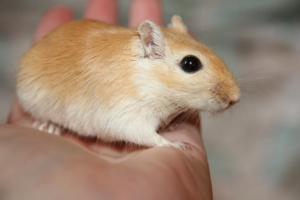Like hamsters, gerbils have become popular pets to keep as they’re small, inexpensive, and easy to care for. There are still some places in the world where certain gerbil species live in the wild, but most of the world’s gerbil population are captive. The most common species for pet gerbils are Mongolian gerbils. While their small size and easy care routine may seem ideal for families, this is not true. Young children can be a danger to these delicate animals and a bad interaction may end in injury to either the gerbil or the child.
Attitude and Behavior

Unlike their counterparts, hamsters or mice, gerbils are not nocturnal. However, they can still be active at night. Much like dogs and cats, their sleep is divided evenly throughout the day and night in short naps.
They are very curious little animals. This can be fun to watch and experiment with. Giving them different objects to explore and watching how they use them can be entertaining for the whole family to watch. You should also be careful to never leave anything potentially harmful within their reach as they may become curious and injure themselves.
In the wild, gerbils live in groups. This means that it is not ideal to keep one gerbil at a time. Typically, same-sex pairs are best, and litter-mates are the best way to find a good match. If you already have an older gerbil, introducing a new one can be difficult since gerbils can be territorial.
Handling
Gerbils can be very docile especially when they are handled properly on a regular basis. They typically do not bite unless they are presented with a threat. This is why it is important to teach anyone who attempts to handle your gerbil exactly how they should do so. It is also why young children should not be allowed to handle the gerbil unless they are under the close supervision of an experienced adult.
Once you have brought your gerbil home, you should give him a few days to adjust before attempting to handle him. Do not abruptly pick up your gerbil. Give them time to be comfortable with you.

Start by offering your gerbil a few treats through the bars on their cage. Once they have accepted those treats without hesitation, open the cage door and offer treats that way. After your gerbil has accepted a few treats directly from your hand through the open cage door, place a treat in your palm and wait for your gerbil to sit on your hand. Once he seems comfortable sitting in your hand to eat treats, start placing treats on your arm.
After you have established trust with your gerbil you can carry him in cupped hands. Never squeeze your gerbil or pick him up by the tail. In fact, you should avoid touching their tail. Most gerbils enjoy light scratching on the sides and back of their head.





